
The northern tower of the Golden Gate suspension bridge appears on the right.
Layers of fog barricaded the "Golden Gate" of San Francisco Bay on this April morning. Peaks of two red towers lurked from atop the gray shroud, and murky fingers of mist strayed well into the Bay itself --- almost touching the other side.
Some distance away from this, in the Mission District of San Francisco, I entered the city’s old Hall Of Justice. Tucked in the back was the San Francisco City and County Medical Examiner’s Office.
Death Report
The medical examiner came out of a storage room with an old ledger book that was open to "DEATH REPORT CORONER’S OFFICE." The report, which appeared on two and one-half pages, identified Henry Washington Dodge, and briefly described the circumstances leading to his death. "That’s quite a piece of history, eh?" the examiner said.

Dodge had been shot with a .32 caliber revolver in the basement of the Carlton Apartments, at 840 Powell Street, San Francisco, California, on June 21, 1919, at approximately 4:10 p.m. The porter, George Hurd, found Dodge on the elevator after it came up to the first floor. At around 6:00 p.m. that day, he was admitted to the St. Francis Hospital with a skull laceration and fracture, and died there on June 30, 1919, at 9:40 a.m. Dodge was 60 years old. On July 3, 1919, after interviewing neighbors, Dodge’s physician, the police detective, Mr. Hurd, and Mrs. Washington Dodge, the San Francisco coroner’s jury deemed the death to be suicide because Dodge was "temporarily imbalanced" at the time of his mortal wounding.
"That’s all there is," the examiner stated. "Any police reports, the gun, or evidence would have been destroyed many years ago."
So that was all: a respected public official, tax assessor, public trustee, political party official, prominent banker and financier, physician, University of California faculty member, rancher, Lafayette Park property owner, San Francisco society icon, corporate executive, survivor of the Titanic disaster, husband and father, Dr. Dodge, died tragically and, of course, unexpectedly. Nonetheless, from the medical examiner’s vantagepoint, it was simple, as if his time had come.
Perhaps it had.
Dead Man’s Resurrection
Henry Washington Dodge was born in Sonora, in Tuolumne (pronounced "Too-all-me") County, California, on June 3, 1859. Located approximately 155 miles due east of San Francisco, near beautiful Yosemite National Park, Sonora was established in 1848 by miners who emigrated from Sonora, Mexico.
Gold was discovered there on March 17, 1849. Originally little more than a camp, the town was incorporated on May 1, 1851. Charles F. Dodge (probably some relation to the subject of this story) served as the first mayor. Sonora was located in the very heart of California’s "Gold Country," and served as the County seat. Its main street was named "Washington."
Washington Dodge's father was Mark Tyler Dodge, one of California's early settlers, who practiced as a physician. Mark Dodge married Eliza Lawrence Rodgers on March 25, 1855. Together, they had two children, Washington, and Adelaide Louisa Dodge.[1] Mark died, however, in 1866, when Washington was very young --- barely six years of age.
Washington Dodge attended the Boys High School in San Francisco, then the University of California, beginning in 1881. He obtained his medical degree in 1884. Later on, he became a member of the Medical Department’s faculty with the title of Professor of Therapeutics. Dodge also served in capacities with various of the local hospitals, and practiced as a physician. One book on San Francisco personalities described Dodge as follows:
"Dr. Dodge is eminently a self-made man. His father having died when he was six years old; he has since his early childhood been thrown entirely on his own resources, and has built for himself a credible position in the medical profession"[2]
Dodge married Alice Lampson Shepard, on February 11, 1891, in a widely reported San Francisco society event. It was attended by many of San Francisco’s elite.[3] Alice was the daughter of Dr. R.M. Lampson, a pioneer physician in California, who served in the State Senate and participated in the State’s original constitutional convention.[4] Washington and Alice had a son, Henry Dodge. He divorced Mrs. Shepard[5] in 1902. Dr. Dodge then married Ruth Vidaver. They had one child, Washington Dodge, Jr., in 1907.
"Blackboard Politics"

Photograph from San Francisco Public Library’s San Francisco History Collection, Wellington C. Wolfe, "Men Of California," p. 202 (The Pacific Art Co., San Francisco, 1901)
Dr. Dodge became active in local politics. In 1896, he was elected to the San Francisco Board of Supervisors. After serving one term as supervisor he was elected to the Office of City and County Assessor, in 1899, where he served until 1912. In that role Dodge became quite popular, because he managed to "swell" the tax rolls with assessments against certain unpopular "quasi-corporations" in San Francisco, such as street railways, gas, electric, and water companies, which had escaped taxation in the past. As such, Dodge elevated the tax collection by approximately $50,000,000. This, in turn, lowered taxes for property owners and others in San Francisco. In particular, Dodge lowered assessments for older improvements, chiefly homes of San Francisco residents.[6]
In his campaigning, Dodge was known for his memorable "blackboard." He used it to write on and to show audiences the clear inequities that existed in the tax structure, as well as the manner he was dealing with them. He was elected, and re-elected.[7]

Photograph from San Francisco Library’s San Francisco History Collection, "Master Hands In The Affairs Of The Pacific Coast," Pgs. 90-91 (San Francisco Western Historical And Publishing Co. 1892)
Dodge was reported to be "frank and unassuming," deliberate, methodical, and in particular, was the type of person who always thought carefully before speaking. But, he spoke with a "vein of humor running through his conversation, and with ability to grasp without apparent effort, the most difficult or complex propositions."[8]
Dodge was a Democrat, and an associate of Gavin McNab, the local Democratic party chief who was often referred to as "the Scotchman."[9] Dodge also closely worked with the wealthy James Duval Phelan, San Francisco’s mayor, and later a U.S. senator.

Photograph courtesy of the San Francisco Public Library’s History Collection, Wellington C. Wolfe, "Men Of California," p. 136 (The Pacific Art Co., San Francisco 1901)
Dodge fostered a public image that he was "honorable" --- a man of great integrity. For example, he sued the editor of the San Francisco Examiner for libel when that newspaper ran a story which reported Dodge had not assessed taxes on a certain club used by his Democratic friends. The editor was actually arrested, taken to jail, and had to post a bail bond.
One of Dodge’s close friends was Fremont Older. The managing editor of the San Francisco Call Bulletin, Older was the consummate insider, and to some degree, a crusader or progressive.
The San Francisco Graft Scandals
Unlike Los Angeles, San Francisco was a working-class town in Dodge’s day, where labor alliances were powerful. In the early 1900s, the administration run by the Union Labor Party’s Mayor Eugene Schmitz and his attorney, Abraham Ruef, were in control. Schmitz and Ruef were popular, but corrupt. They had sold city franchises related to certain municipal businesses, such as the telephone or railway systems, for cash. Pacific Telephone, for example, paid $50,000 to get the city’s telephone franchise. Home Telephone made a competing bribe. Another hotly disputed matter was the construction of an overhead trolley system. Ruef and United Railway wanted an overhead system. Their opponents, including wealthy Rudolph Spreckels, wanted it to be underground.
In 1905, just before the San Francisco earthquake, Mr. Older contacted Dodge in connection with gaining a political favor. Older had a plan for getting rid of Ruef and Schmitz.

Older proposed that the Democratic and Republican parties "fuse" together to oust Ruef and Schmitz. He asked Dodge to ask his friend McNab not to run for mayor on the Democratic ticket. This would allow the Republican candidate, John S. Partridge, to win a majority of the votes. Older and Dodge met at the San Francisco Palace Hotel’s garden court, and agreed to the deal. In exchange, Older promised that he would not disclose his knowledge of a client of McNab’s bribery of a state senate committee, in Sacramento. Older described the event as follows:
That evening my wife and I were at the Palace Hotel.
I asked Dr. Washington Dodge to come up to my room. He came. I said: "Doctor, I hate to ask you to do this, but I'm desperate. It's the last shot in my locker. The Democratic caucus meets tonight at 8 o'clock. I want you to go over and see McNab. I want you to tell him that unless Partridge is nominated at 8 o'clock tonight I will go to Grove L. Johnson, attorney for Emmons, and I will tell him to ask me, when I am on the stand as a witness, whether or not Grange intended to bribe the Senate committee.
"My God! That's an awful thing to ask me to do," Dodge replied.
"I know it. But you must do it, doctor. I'm desperate. I must have Partridge nominated. I tell you we've got to beat Schmitz."
"All right," he said. "I'll do it."
He went away, and shortly afterward Mrs. Older and I went down to dinner. We were sitting at our table, in the old Palm Court of the Palace, when I happened to look up. Through the glass that surrounded the court I saw the white face of Dr. Dodge. I rose and went out to him.
He was much agitated. He said: "I gave the Scotchman your message." I waited, and he went on. "His reply was: `Tell that long-legged blank blank blank that if I am alive at 8 o'clock tonight Partridge will be nominated.
Thus, in response to Older’s and Dodge’s threats of blackmail, McNab agreed not to run. Schmitz was re-elected as mayor anyway.[10]

Photograph from San Francisco Public Library’s San Francisco History Collection, Wellington C. Wolfe, "Men Of California," p. 174 (The Pacific Art Co., San Francisco 1901)
Not surprisingly, the failure of the Older and Dodge’s "fusion" scheme was humiliating for McNab. And Ruef did his level best to rub it in. On election night, in November 1905, during celebrations in San Francisco’s roughshod working class "Tenderloin" district, it was reported that Ruef delivered to McNab an open coffin:
The Tenderloin went wild . . .with delight . . . Ruef was the master of revels and his remarkable brain devised all sorts of insults to the fallen foe. Among the other things he gave orders for a funeral procession and to the strains of the Dead March from Saul a drunken mob of his wardheelers marched through the downtown streets, finally depositing a coffin on the threshold of the Occidental Hotel. Gavin McNab lived at the Occidental and the coffin was meant for him.[11]

Dodge’s friend James Phelan owned the properties in this area that were purportedly underassessed for property taxes. However, a probe by a grand jury cleared Dr. Dodge of any wrongdoing.
Later, in 1906, Dodge had to appear before a grand jury to answer for his purported failure to properly assess the taxes for valuable properties on Market Street owned by his political friend, Mr. Phelan. There was no indictment, but Dodge complained afterward that there was a stigma to even having to appear before the jury.[12] The local community maintained their support for Dr. Dodge. In particular, the local Business Review described Dodge as a "good public official," and noted that "there is in this community a general and high appreciation for his work."[13] Eventually, the grand jury sustained Dr. Dodge’s assessment,[14] and even complimented him for his work.[15]
Meanwhile, United Railway had $200,000 delivered to its office in San Francisco. The money was received in gold. Then, the company exchanged it for bills at the United States Mint, and used it to bribe city officials. Supervisor Gallagher alone received $15,000.[16] Not surprisingly, the San Francisco Board of Supervisors approved the overhead trolley system for the City.[17]
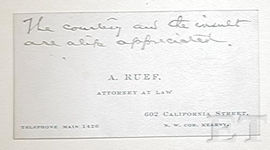
The card is dated September 6, 1905 on its backside.
The card is presently in the San Francisco History Collection at the San Francisco Public Library.
That event, apparently, was the last straw. While Schmitz was taking a lavish trip to Europe, aboard the Cunard steamship Caronia, the District Attorney, W. H. Langdon, obtained a court order to arrest Ruef, and have him detained at the St. Francis Hotel.[18] In a sort of mini-"Saturday Night Massacre,"[19] Ruef tried to have acting mayor, James Gallagher, fire Langdon and appoint Ruef as D.A.[20] This failed, and the Court ordered Ruef to be jailed. Schmitz immediately embarked for home aboard the Hamburg-American liner, Patricia,[21] but it was too late. He was indicted, along with Ruef. Angry mobs attacked Older’s offices, a bomb blew up at Gallagher’s home, the prosecutor, Francis Heney, was shot in the face, and Older was kidnapped in midday off busy Van Ness street, taken on a train to Santa Barbara, and almost killed. But Ruef was eventually convicted and sent to San Quentin Prison.
Notably, the grafters’ defeat may have been an empty victory for the friends of Dr. Dodge. Later, for example, Older sought a pardon for Ruef because, in part, he felt that his group of friends was no better than Ruef. According to Older, Ruef’s mistake was that he "got caught."[22]
Laguna Street
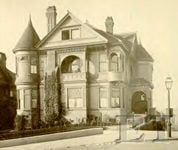
The garage where the explosion occurred would have been in the back.
Photograph re-published with the written permission of the San Francisco Public Library.
One of the persons involved in the graft scandal, who was never prosecuted, was the Chairman of the Board of Pacific Telephone & Telegraph Company, Henry T. Scott. His company, for example, had offered the Schmitz administration a $50,000 bribe. Scott lived in a huge mansion at 2129 Laguna Street that was built in the 1880s. In 1901, in fact, President William McKinley had stayed at the residence during a visit to dedicate the monument in Union Square to Admiral Dewey, hero of the Spanish-American War.
The home bordered on beautiful Lafayette Park, on the southern side of the Clay and Laguna Streets intersection.
Scott left for posh Hillsborough, to the south of San Francisco. The Dodge family took up residence in the former Scott mansion which, incidentally, was located only one black away from "Washington" street in San Francisco.
In 1908, newspapers reported that Dodge suffered a "narrow escape from serious injury." He was in the garage at the residence working on his car. Looking underneath at the running gear, Dodge lighted a match so he could see.
The rest of the incident was described as follows:
A sheet of flame shot through the garage, accompanied by a loud explosion. The next instant the Assessor’s mustache, eyebrows and hair were badly singed. Dazed for the moment, Dr. Dodge stood in wonderment.

It is located approximately two blocks away from where the Dodge mansion stood. The steep decline of Laguna Street from the top of Nob Hill towards the Bay is apparent from this photograph.
Fortunately, the vehicle’s gas tank didn’t explode. The source of the blast proved to be a "little dripping fluid."[23]
In the early 1900s, the Lafayette Park area of San Francisco was a magnet for the City’s wealthy elite. Many huge mansions were built that still surround the park.
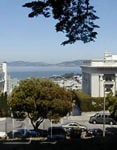
The enormous Adolph Spreckels mansion is shown in the foreground, at the right.
Lafayette Park itself is relatively small, with a high bluff from which one can view the downtown area of the city, or alternatively, the San Francisco Bay. The Dodge home was at the very top of Nob hill and Laguna Street, which declines sharply toward the Bay.
During the 1906 earthquake, much of the Pacific Heights area, which encompasses the Park, was destroyed by the fire that followed the earthquake. Luckily, the homes around the Park were preserved for posterity. Immediately after the quake, Lafayette Park served as a campground for homeless people – many of whom set up tents and lived there until new lodgings could be built.
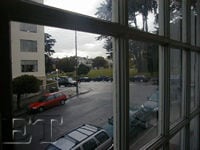
Interestingly, in 1911, Dr. Dodge had a roof installed on the mansion for the price of $40.00, as the construction permit shows.
Dodge’s neighbors were all wealthy and respected San Francisco citizens. Among them were the President and Vice President of Levi Strauss & Co., Sigmund Stern. Stern and his brother had married into the Eugune Meyer family, formerly of San Francisco. Meyer left San Francisco for New York, in 1893, when he became a partner in the investment banking house of Lazard Freres. His son was Eugene Meyer, Jr., who became a major financial and political icon, and whose daughter was the late Katherine Graham, of Washington Post fame.[24] Edgar Meyer was Eugene, Sr.’s other son. His daughter Rosalie was married to Sigmund Stern.
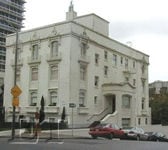
The Titanic Disaster
Dr. Dodge decided to go to Paris for treatment of his blood disease.[25] He bought tickets for his family, and was to return aboard the steamship Titanic, embarking from Cherbourg, France, on April 11, 1912. Said to be "unsinkable," the Titanic was on its maiden voyage from Southampton to New York. On Sunday, April 14, 1912 the steamship apparently failed to heed ice warnings from other ships. It sailed at its top speed into an ice field, and eventually, at approximately 11:40 p.m., struck an iceberg. The lifeboats did not have sufficient capacity to carry all of the ship’s passengers. While many third class, or steerage passengers remained below, the first class passengers got into the boats, particularly the women and children.

Ruth and Washington, Jr. managed to get into one lifeboat. Separately, Dodge later explained that he had "tumbled" into Boat No. 13, and survived.[27] While Dodge, his family and 700 other people made it, nearly 1,500 men, women and children died in the freezing waters of the North Atlantic when the ship sank at 2:20 a.m., on April 15, 1912.
From Boat No. 13, Dodge heard the cries of these people until they eventually faded out. Within a couple of hours a rescue steamship named Carpathia appeared. It recovered all of the persons in lifeboats, including Ruth, Washington, Jr. and Dr. Dodge.

While Dodge was returning aboard Carpathia one "C. Atschul" in New York attempted to inquire directly from him about the status of fellow passenger Edgar Meyer.[28] Apparently, Dodge did not actually receive the marconigram. In any event, Edgar Meyer had gone down with the Titanic. Meanwhile, Dodge sent a wire to "N. Vidaver" in New York City, and to son, Henry, in San Francisco, to the effect that the family was safe.
The San Francisco Mayor, James Rolph, Jr. expressed concern for the Dodge family’s welfare.[29] Eventually, Ruth gave an interview.[30]

On May 11, 1912 Dr. Dodge addressed San Francisco’s Commonwealth Club about the disaster.[31] It was noted in newspapers that during the speech, he became visibly upset, and broke down when he "spoke of the cries of the drowning."[32]
A New Career and a Ranch

Dr. Dodge quit the Assessor’s office[33] and went to work for the Anglo London Paris National Bank, as a vice president.
In 1915, while still a vice president at the bank, Dr Dodge served as a Public Library Trustee and, despite the stigma of having survived the Titanic disaster, seemed to still be very highly regarded. For example, in the 1915 "Exposition Edition" for the Municipal Blue Book, he was described as follows:
As Assessor, he inaugurated many reforms, and discharged the duties of office with honesty and impartiality, which fact was attested to by the enormous majorities which he received at the polls. On the occasion of his last election, his majority was over seventeen thousand votes, a record without precedent in the previous annals of the city."
Dodge served as a delegate to the Democratic National Convention in 1916, where President Woodrow Wilson was re-nominated.
In 1917, Dodge left the bank to run the Federal Telegraph Company.[34] He earned $18,000 a year as the company’s president. Federal Telegraph controlled the shares of Poulsen Wireless Corporation.
He also made plans for retirement, including purchasing a plum tree ranch near Princeton, in Colusa County, California. The ranch was adjacent to the Sacramento River, in a warm, sunny agricultural region known for almond and plum tree farming. It was a huge ranch of some 200 acres.
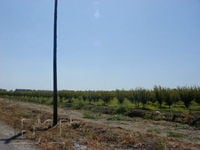
Dodge, in his role as Federal Telegraph’s president, may have thought himself "unsinkable." He and the other directors retained control by means of a 1911 voting trust. The trust held a majority of the voting shares, and as such, gave Dodge and his fellow directors complete control of the company’s affairs.
Newspapers reported that Dodge was working on a big deal with the government, and meeting with major investors in New York City. Eventually, he engaged a sale of substantial Poulsen Wireless’ assets to the United States Government in a $1,600,000 transaction. As part of the deal, it was alleged, an entity associated with Dodge, and his wife’s family, was to receive a huge portion of the $400,000 commission from the sale. The entity that was to receive the commission was "Valencia Corporation," and its representative was reported to be none other that Nathan Vidaver, a lawyer and a member of Dr. Dodge’s wife’s family.
The Federal Telegraph Company Scandal
This transaction was apparently not in the company’s best interests. The value of Poulsen stock, or Federal Telegraph, or both, declined, markedly – from roughly $15 to $4 or $5. Several shareholders, including two associated with the Anglo London Paris National Bank’s affiliate, Anglo California Trust Company, Tilden Tegnazzini and Charles Legge, filed a lawsuit against Dr. Dodge.[35]
Dodge had sold most of his shares when the price was high. This angered the other shareholders, including, Lazard Freres, T. Coleman Dupont, Sigmund Stern and others.
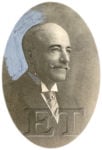
Photograph republished with written permission from San Francisco Public Library.
Stern was the president of Levi Strauss & Co., in San Francisco. His wife, Rosalie, was Edgar Meyer’s sister. The Lazard Freres investment banking house had been closely associated with the Meyer family for many years. Dupont was a leading Republican Party figure, who headed the Republican National Committee, almost ran for Vice President of the United States, and later became a U.S. senator. They were represented by Hiram Johnson, Jr., the son of the former California governor, and at that time, U.S. Senator, Hiram Johnson.
The shareholders were determined to oust Dodge from the presidency of Federal Telegraph. Dodge protested, declaring that as a matter of his "honor" he would work to recover the shareholders’ losses. But the shareholders would have none of that. On January 14, 1919, Dodge and several other directors were forced to resign, and their control under the voting trust was ended. As a blatant slap in the face to Dodge, the shareholders replaced him with the very plaintiff who had brought the lawsuit, Tegnazzini. They also announced that the company would join in Tegnazzini’s and Legge’s lawsuit.[36]

Dodge denied away all of the publicity of friction with the shareholders. He claimed that the others just had a different vision for the company than he did – so he resigned. Dodge also denied that he sold anyone any stock:
The most glaring and vicious misstatement, however, is the one to the effect that I was loath to resign, as honor compelled me to retain my place since I had induced certain rich New Yorkers to buy a large number of shares of Poulsen stock . . . I never knew these parties. I never sold them any stock . . .[37]
McNab, who represented Dodge during the Federal Telegraph scandal and in the Tegnazzini-Legge litigation, later stated that the matter "preyed upon" Dodge’s "mind" because it "reflected on his honor."[38]
840 Powell Street
Meanwhile, Dodge sold his mansion on Laguna Street.[39] He took his family to the lavish Carlton Apartments at 840 Powell Street, near the intersection of Powell and Market Streets.
On June 21, 1919, Dodge was found by the porter in the elevator. He had been shot in the basement of the building.[40]
After Dodge was taken to the St. Francis Hospital, his condition seemed to improve. His doctor indicated that he might survive the ordeal. However, on June 29, 1919, Dodge took a turn for the worse, and with all family members present, passed away the next day.[41]
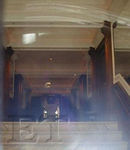
On the day of Dr. Dodge’s death, the noted San Francisco architect Harry Smith’s final architectural plans were approved for the construction of the apartment building at the site of Dodge’s former Lafayette Park mansion.
Epilogue
Ruth Dodge was named the executrix of the Dodge estate, and paid $500 per month in that capacity. She and Dodge’s first son Henry were the principal beneficiaries.[43] The Dodge estate was said to be worth $100,000, according to the San Francisco Examiner.
Later, an auditor reported that the sale to the U.S. government, which Dodge had done, "took the life blood" out of the Federal Telegraph Company. It produced a book loss of nearly $22,000,000.[44]
In 1921, Federal Telegraph filed a claim against the Dodge estate for $480,000.[45] The estate countersued for $224,000.[46] Later, the parties settled the claims for a $15,000 payment to Federal Telegraph. As part of the settlement, the company represented that its investigation had not uncovered any fraud on Dodge’s part. Probate Judge Thomas F. Graham concluded that Dodge was "cleared."[47]

The document is presently in the San Francisco History Collection at the San Francisco Public Library
Ruth went to the prune ranch in Colusa County and was reported to visit San Francisco on occasion. Eventually, she returned to her family in New York City.
The ranch is known today as the "Dodge Ranch" in Princeton. And, local historians recall "Dr. Dodge." The ranch borders, in fact, on "Dodge Road."
What happened to Dr. Dodge? Consider, first, the man’s accomplishments: Dr. Dodge had practiced as a physician, served with the University of California’s Medical faculty, served as member of the San Francisco Board of Supervisors, and as Assessor for some 12 years, developed an image of respect and integrity, won elections in the context of highly corrupt politics, testified before a grand jury which questioned his tax assessments for his Democratic Party friends, opposed Ruef and Schmitz, orchestrated political deals with Older in secret, survived the Titanic disaster, owned a large ranch, a Lafayette Park mansion, and successfully changed careers several times. He served for years with a major international bank, and as a Public Library Trustee. He ran a major publicly owned company. And he was a well-known member of the San Francisco social elite who, for example, was asked to speak to his colleagues at the prestigious Commonwealth Club. He served as delegate to the National Democratic Convention in 1916. He married twice, one time to a major figure in San Francisco society, Alice Lampson, and he had two children. He took care of his mother, Eliza, [48] who had been widowed many years before. Dodge was a man of high achievements. His father died when Dodge was very young. Yet he worked his way up, and made something of himself.
On June 30, 1919, he was dead from a gunshot wound.
Assuming, for purposes of discussion, that Dodge wasn’t murdered[49] – one possible explanation is that events over time took their toll on him. His experience with the Titanic disaster, in particular, was a watershed event in his life. It devastated him.[50] This was most evident when he broke down and cried during the May 11, 1912 Commonwealth Club speech.
Left unresolved, an acute traumatic reaction such as the one Dodge exhibited at the May 11 speech from his Titanic experience, re-appears, again and again, when a new and different event somehow triggers it. Each time it manifests more severely than on the previous occasion, and gradually, it can overwhelm the psyche. Additionally, like many other men who survived the disaster, Dr. Dodge was probably stigmatized as a coward because he survived while women and children died. Such an inevitable psychological destruction would have become, metaphorically speaking, an "iceberg" for Dodge to have to constantly confront in his post-Titanic years. Dodge’s general health, on account of which he had gone to Paris in the first place and returned aboard Titanic, was not so good.
It’s possible that the Titanic disaster played an underlying role in the Federal Telegraph scandal. Some of the shareholders were relatives of Edgar Meyer, a fellow passenger who had honorably sacrificed himself so that women and children could be rescued.[51] This fact may have colored these shareholders’ perception of Dodge, who had survived the disaster.
Dodge always presented himself as an "honorable" man, and even jailed a newspaper editor who hinted otherwise --- such a dishonorable stigma as having survived the Titanic disaster would have been devastating for him personally. But, by the same token, with his constant emphasis on "honor" Dodge had already set him up for a severe fall from grace if he came to be perceived as dishonorable.

When the Federal Telegraph financial calumny came about, Dodge didn’t have the support he had received from the public and friends in the past. These shareholders were, obviously, no ordinary foes. They kicked Dodge out of the company’s presidency, humiliated him in the press, and then elected his enemy, Tegnazzini, to take his place. Dodge bitterly reacted to their actions, as is evident in the San Francisco Chronicle’s January 19, 1919 article wherein he audaciously describes the shareholders as "certain rich New Yorkers" and insists that "I never sold them any stock."
Fremont Older, one of the attendees at Dodge’s funeral on July 3, 1919, tried to explain men like Dodge in the following passage from My Own Story, published that year:
Life puts a heavy strain and pressure on some of us, and unconsciously we find ourselves departing from the conventional standards set up by those whom nature, or the chance of birth, has favored. Not one of us is pure white nor solid black. We are a blend—a gray; rather a dark shade of gray at that . . . blindly groping toward the good.[52]
It was late afternoon. I had finished up at the Medical Examiner’s office, taken the trolley with the overhead electric lines, and walked to Lafayette Park in Dodge’s Pacific Heights neighborhood. As I looked down the hill toward the Bay, the bright, sunny almond and plum trees fields of Dodge Ranch came to mind. The fog at the Bay’s entrance had cleared. The famous suspension bridge with its red towers was visible, and the waters surrounding it were unusually calm. As damp cold air permeated the city, the temperature dropped sharply. The forecast, I learned, was "clear." It would be a beautiful starlight night.
[47] "Federal Telegraph Suit dismissed," San Francisco Examiner, December 9, 1922.
[48] Eliza died in San Francisco, in 1925. Source: Patricia Perry, City of Sonora Historical Director).
[49] This article does not address the issues surrounding the fact that Dodge may have been murdered. However, by not touching on this subject, the author does not intend to imply that this would not have been a possibility, or likelihood. According to messages posted on the Encyclopedia Titanica message board, the Dodge family contends that Dr. Dodge was murdered. In any event, whether or not Dodge died at someone else’s instance is simply not addressed here.
[50] For example, seaman Albert Fryer, who was also rescued in Boat No. 13, never spoke of the Titanic disaster for the rest of his life. When it was brought up, he told his family, that he didn’t want to hear about it, and that they "didn’t know what it was like." (Source: e-mail from Fryer’s son, Harry Fryer).
[51] Encyclopedia Titanica: First Class Passenger: Edgar Joseph Meyer Accessed Tue Feb 12 13:19:53 2002.
[52] Fremont Older, My Own Story, Conclusion (Call Publishing Co., San Francisco 1919). This book is available on line at http://www.zpub.com/sf50/sf/.
Comment and discuss